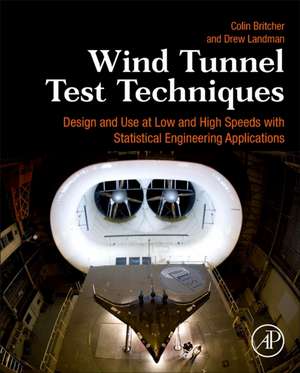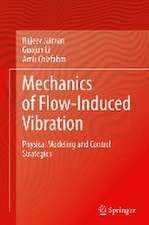Wind Tunnel Test Techniques: Design and Use at Low and High Speeds with Statistical Engineering Applications
Autor Colin Britcher, Drew Landmanen Limba Engleză Hardback – 24 oct 2023
- Deals with a broad range of flow speeds in wind tunnels, from low speed to high speed
- Provides a discussion of similarity laws as well as material on statistical analysis
- Includes coverage on facility-to-facility and facility-to-CFD correlation
- Presents advanced topics such as cryogenic wind tunnels, ground simulation in automotive testing, and propulsion testing
Preț: 1410.16 lei
Preț vechi: 1938.48 lei
-27% Nou
Puncte Express: 2115
Preț estimativ în valută:
249.54€ • 292.61$ • 219.14£
249.54€ • 292.61$ • 219.14£
Carte tipărită la comandă
Livrare economică 30 ianuarie-13 februarie 26
Preluare comenzi: 021 569.72.76
Specificații
ISBN-13: 9780128180990
ISBN-10: 0128180994
Pagini: 670
Ilustrații: Approx. 1000 illustrations
Dimensiuni: 152 x 229 x 38 mm
Greutate: 1.23 kg
Editura: ELSEVIER SCIENCE
ISBN-10: 0128180994
Pagini: 670
Ilustrații: Approx. 1000 illustrations
Dimensiuni: 152 x 229 x 38 mm
Greutate: 1.23 kg
Editura: ELSEVIER SCIENCE
Cuprins
SECTION 1 Introduction
1. A brief history of the genesis of wind tunnels
2. Types and uses of wind tunnels
3. Dynamic similarity
SECTION 2 Wind tunnel design and circuit aerodynamics
4. Subsonic wind tunnel design
5. Boundary interference assessment, alleviation, and correction
6. Model supports and support interference evaluation
7. Transonic wind tunnels
8. Supersonic wind tunnels
9. Hypersonic test facilities
10. Force and Moment Balances
11. Model design and construction
12. Special topics
SECTION 3 Operational and Test Procedures
13. Statistical Engineering Practices
14. Wind tunnel calibration
15. Flow quality assessment
16. Force and moment measurements
17. Facility instrumentation
18. Planning of Test Campaigns
SECTION 4 Wind tunnel test techniques
19. Pressure surveys
20. Dynamic testing
21. Facility-to-facility, facility-to-CFD, facility-to-flight correlation
SECTION 5 Measurement Techniques
22. Flow visualization
23. Nonintrusive quantitative flow field measurements
SECTION 6 Postscript
24. The role of CFD in aerodynamic research
25. The future of ground testing
SECTION 7 APPENDICES
A. A primer on statistical engineering
B. Strain-gage balance calibration example
1. A brief history of the genesis of wind tunnels
2. Types and uses of wind tunnels
3. Dynamic similarity
SECTION 2 Wind tunnel design and circuit aerodynamics
4. Subsonic wind tunnel design
5. Boundary interference assessment, alleviation, and correction
6. Model supports and support interference evaluation
7. Transonic wind tunnels
8. Supersonic wind tunnels
9. Hypersonic test facilities
10. Force and Moment Balances
11. Model design and construction
12. Special topics
SECTION 3 Operational and Test Procedures
13. Statistical Engineering Practices
14. Wind tunnel calibration
15. Flow quality assessment
16. Force and moment measurements
17. Facility instrumentation
18. Planning of Test Campaigns
SECTION 4 Wind tunnel test techniques
19. Pressure surveys
20. Dynamic testing
21. Facility-to-facility, facility-to-CFD, facility-to-flight correlation
SECTION 5 Measurement Techniques
22. Flow visualization
23. Nonintrusive quantitative flow field measurements
SECTION 6 Postscript
24. The role of CFD in aerodynamic research
25. The future of ground testing
SECTION 7 APPENDICES
A. A primer on statistical engineering
B. Strain-gage balance calibration example











